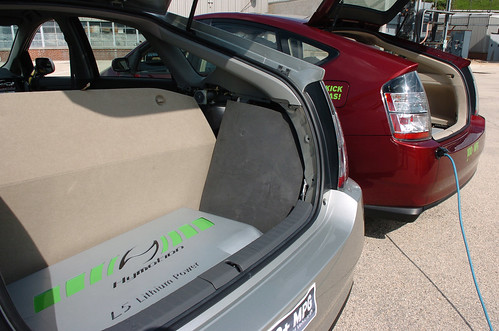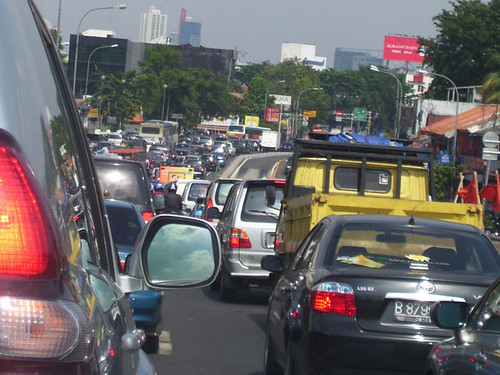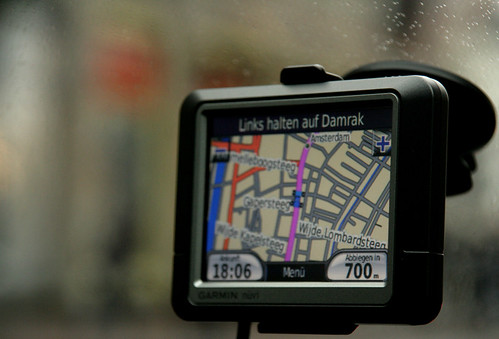Are plug-in electric cars the new ethanol? – A Right-winger questions the Government’s investment strategy
(Source: Examiner & Autobloggreen)
In the name of “clean energy,” Washington is subsidizing a switch from gasoline-powered cars to cars powered mostly by coal. In pursuit of “energy independence,” the feds may foster addiction to a fuel concentrated in a socialist-run South American country.
Lobbying by automakers, chemical companies and coal-dependent power producers has yielded a slew of subsidies and mandates for electric cars. However promising a gasoline-free automobile may sound, anyone who followed the government’s mad rush to ethanol fuel in recent years has to worry about the clean promise of the electric car yielding dirty results.
Ethanol — an alcohol fuel made from corn or other plants — has been pushed relentlessly on the American people by a Congress under the influence of a powerful ethanol lobby. Touted as a clean fuel, the government-created ethanol boom has contributed to water pollution, soil erosion, deforestation and even air pollution.
Lithium could be the new ethanol, thanks to the government push for electric cars. Lithium is an element found in nature, and lithium-ion batteries are at the heart of the next generation of electric cars. Compared with lead acid (the standard car battery) and nickel metal hydride (the batteries in today’s hybrids), lithium-ion batteries are less toxic, more powerful and longer lasting.
But what would happen if electric cars and these batteries gain wide use?
Before we even get to the batteries, recall that although all-electric, plug-in cars emit nothing, somebody needs to burn something for the car to move. Here, the burning happens at the power plant instead of under your hood.
The Department Energy estimates that coal provides half our electricity. A recent Government Accountability Office study reported that a plug-in compact car, if it is recharged at an outlet drawing its juice from coal, provides a carbon dioxide savings of only 4 to 5 percent. A plug-in sport utility vehicle provides a CO2 savings of 19 to 23 percent.
The Department Energy estimates that coal provides half our electricity. A recent Government Accountability Office study reported that a plug-in compact car, if it is recharged at an outlet drawing its juice from coal, provides a carbon dioxide savings of only 4 to 5 percent. A plug-in sport utility vehicle provides a CO2 savings of 19 to 23 percent.
If the cleaner and cheaper fuel of a plug-in causes someone to drive even a bit more, it’s a break-even on CO2. GAO co-author Mark Gaffigan raised the question to CNSNews.com; “If you are using coal-fired power plants and half the country’s electricity comes from coal-powered plants, are you just trading one greenhouse gas emitter for another?”
And of course, there’s the lithium lobby. FMC Corp. is the largest lithium producer in the United States. The company employs a dozen lobbying firms and operates its own political action committee. FMC has leaned on Congress and the Energy Department for electric car subsidies.
If the electric car lobby succeeds, brace for another harsh lesson in unintended consequences.
Click here to read the entire Examiner article. Our friends at Autobloggreen were kind enough to point Tim Carney, the author of this Examiner article, the following: While Carney is right that the GAO did warn against all of the coal that could be used to power the EVs of the future, he forgot to mention the GAO’s finding that “Research we reviewed indicated that plug-ins could shift air pollutant emissions away from population centers even if there was no change in the fuel used to generate electricity.”
TransportGooru Musings: Though I agree with some aspects of the author’s argument, I disagree with the notion that Electric Vehicle investment boom is akin to that of the Ethanol-boom of the years past. There are many differences between what’s happening now and what happened in the past. Apart from ridiculing the Government’s strategy, the author, Tim Carney, is not offering any credible solutions and simply terrorizes the readers with an insane argument — Your tax dollars are getting wasted and the lithium lobbies are winning.
Let us see, Mr. Carney! We have two clear choices — either we continue to tread the same path, guzzling billions of gallons of oil a day (and polluting the environment with gay abandon), all the while facilitating the transfer of your dollars to some petro-dictatorship in the Middle East (Saudi Arabia) or South America (Venezuela). Or try and invest in something like Electric Vehicles which can help us and our children breathe easy in the years to come. The latter option may not be very appealing to many folks like you who are grounded in a myopic view of the world.
Though majority of the electric power produced in the US comes from coal, we can to a large degree control the emissions from these coal plants with current technology. It may require some more arm twisting on the Government’s part to make these coal-fired electric plants to adhere to the stringent emissions standards but this is a lot more easy to manage. Also, with more government investment in other forms of generating electricity and a great deal of consumer interest in purchasing clear power, we have golden an opportunity for investing in other forms of electricity production (Nuclear, Wind, solar. etc – FYI, Government data indicate there have been 17 licence applications to build 26 new nuclear reactors since mid 2007, following several regulatory initiatives preparing the way for new orders and the Government envisions producing significant share of the power from Nuclear by 2020).
In this option, the Fed & State Governments can regulate and control these domestic sources of power generation and to a large degree keep the investments within the American borders. If you are advocating to continue the same path as we have done in the past decades, Petro-dictators on the other parts of the globe (Saudi, Venezuela, Russia, etc) are going to grow richer and they do not listen to what you or your government wants. They do what they want and run a cartel (OPEC) that is very unrestrained and at times acts like a bunch of thugs. In this option, your price at the pump is not dictated by your Government but some hukka-smoking, arms-dealing perto-aggresor, who is trying to make the best of the situation and extract as much as he can from your wallet.
The Ethanol buzz dissipated quickly because the Detroit lobby was too damn powerful and them automakers were not listening well to what the customers wanted. When the economy tanked (and the markets wreacked havock on their stock values) and the customers started showing love for foreign manufactured cars like Prius & Insight, Detroit had a sudden realization that they need to change their strategy and started moving away from making those huge SUVs and Trucks. Now they are talking about newer cars that are small, functional, economic and environmentally viable products.
It is hard to disagree that there was a flood of investment in the Ethanol technology, but the underlying concept remained the same (burning fuel using the conventional combustion engine) and there was nothing ground-shaking about the way it was promoted. It is just that we were simply trying to change the amount of emissions coming out of our tailpipes. But now with Electric-vehicles, we are changing the game completely.
Though it may take a few more years to develop the “Perfect” technology, full electrification of vehicles will eliminate the very concept of a tailpipe in a vehicle. Tesla and numerous other manufacturers are trying to do this and I consider this to be a step in the right direction. One thing we have to bear in mind is that during the Ethanol era, the U.S. was the major proponent (because we have way to much areable land and corn growing farmers around) and the rest of the world was just playing along with mild interest because of various reason. But this time around the scenario looks very different. Worldwide there is a coordinated push for heavy investments in alternative energy technologies, and almost every industrialized nation jumped into this EV bandwagon pushing research funds towards development of green cars when the oil prices sky rocketed. No one is interested in paying $140+ dollars/barrel for oil.
Above all, we are at a time when the Government needs to invest its tax-payer dollars back in the communities in a fruitful way. The addiction to oil has gotten way bad and the sky-high oil prices of 2008 were a good indicator that we can’t afford to continue treading in the same path as we did in the decade past. If the Government has to hold back from investing in clean energy technologies, it might invest in other areas that may look very appealing in the short run but potentially leaving a huge developmental hole in the transportation sector. This is the RIGHT TIME for investing in Electric Vehicles. Now the Government has a stake in two of the three Detroit Automakers, which offers the flexibility to steer the development of new technologies and newer vehicle platforms running on clean fuels such as electric and hydrogen power.
Going by your argument that by switching enmass to Electric-vehicles, we are going to create a demand for Lithium, simply shifting our oil dependence to socialist-Bolivia’s Lithium reserves, so be it. You want to know why? Any day, I’ll take the Democratically-elected Bolivian Government (headed by a Evo Morales) over the petro-crazy OPEC members. If it helps resuscitate a nation that is living in depths of poverty, why not do that. We in the Western world helped the Saudi’s & other mid-east monarchs become rich and modern from their goat-sheperding Bedouin past with the invention of modern Automobiles. If we can do the same to Bolivia with the introduction of a new technology (Lithium-ion batteries for running cars), why do you get so jittery about that.
The growing threat of environmental degradation and the fallout from the rising green house gas emissions fore-casted by our eminent scientists are too damn threatening to our world and hard to ignore. Be happy thinking that your Government is doing something to improve the status-quo (which is guzzling billions of gallons of oil) instead of sitting around waiting for a miracle. For all that matters Electric Vehicles may be just an evolution in the quest for a better form of transportation. Who knows! But by investing in these technologies, we may at least have a chance to live a better life in the future. If our Government is not doing any of the above, we may never have a future after all. So, let’s stop being an obstacle along the way for everything the Government does just because it is run by people who have a diabolically different views and principles.













